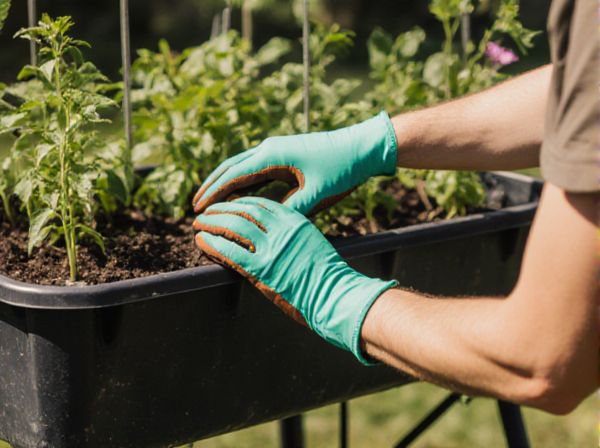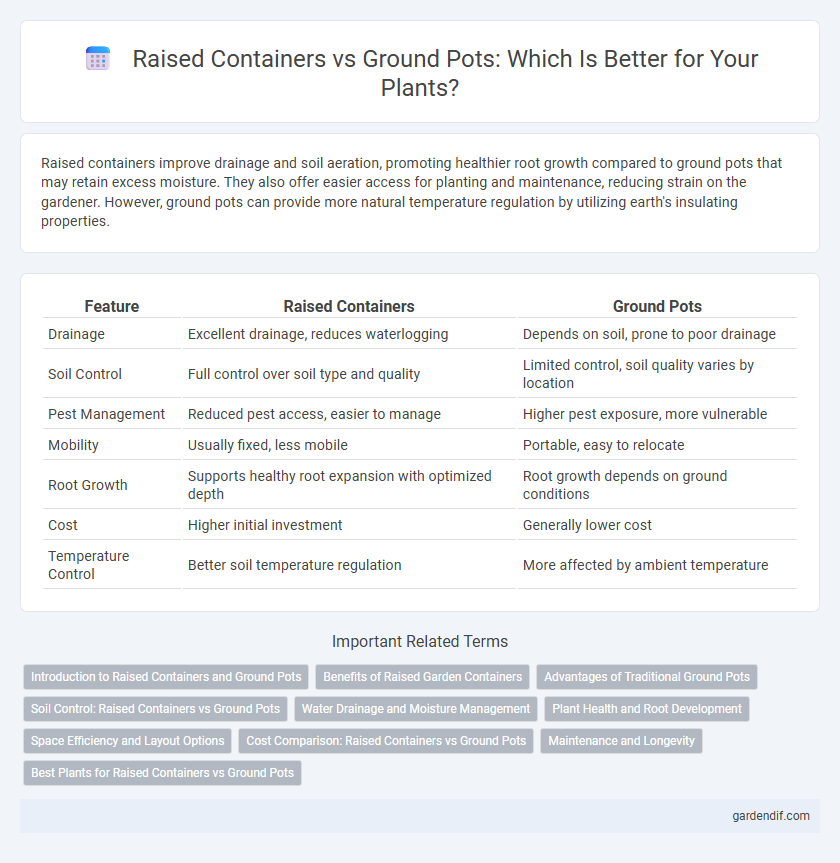
Raised containers vs ground pots Illustration
Raised containers improve drainage and soil aeration, promoting healthier root growth compared to ground pots that may retain excess moisture. They also offer easier access for planting and maintenance, reducing strain on the gardener. However, ground pots can provide more natural temperature regulation by utilizing earth's insulating properties.
Table of Comparison
| Feature | Raised Containers | Ground Pots |
|---|---|---|
| Drainage | Excellent drainage, reduces waterlogging | Depends on soil, prone to poor drainage |
| Soil Control | Full control over soil type and quality | Limited control, soil quality varies by location |
| Pest Management | Reduced pest access, easier to manage | Higher pest exposure, more vulnerable |
| Mobility | Usually fixed, less mobile | Portable, easy to relocate |
| Root Growth | Supports healthy root expansion with optimized depth | Root growth depends on ground conditions |
| Cost | Higher initial investment | Generally lower cost |
| Temperature Control | Better soil temperature regulation | More affected by ambient temperature |
Introduction to Raised Containers and Ground Pots
Raised containers offer improved drainage and soil aeration, promoting healthier root growth and easier maintenance compared to traditional ground pots. Ground pots, embedded directly into the soil, provide natural insulation and stability but may face challenges like poor drainage and soil compaction. Selecting between raised containers and ground pots depends on factors such as crop type, soil quality, and environmental conditions.
Benefits of Raised Garden Containers
Raised garden containers improve soil quality by allowing precise control over soil composition and drainage, reducing soil compaction and promoting healthy root growth. They protect plants from ground-dwelling pests and weeds, minimizing the use of pesticides and reducing maintenance. Elevated containers also extend the growing season by warming faster in spring and can be easily accessed, making gardening more ergonomic and accessible.
Advantages of Traditional Ground Pots
Traditional ground pots offer superior thermal insulation, maintaining consistent soil moisture and protecting plant roots from temperature fluctuations. Their stability prevents tipping and allows deeper root growth, promoting healthier and more resilient plants. Ground pots also enable nutrient exchange with surrounding soil, fostering a natural growth environment beneficial for long-term plant development.
Soil Control: Raised Containers vs Ground Pots
Raised containers provide superior soil control compared to ground pots by allowing precise management of soil composition, drainage, and moisture levels, reducing the risks of soil-borne diseases and pests. The elevated structure enhances aeration and prevents soil compaction, promoting healthier root development and better nutrient uptake. Ground pots, while convenient, often suffer from variable soil conditions and limited drainage control, potentially leading to waterlogging or nutrient depletion.
Water Drainage and Moisture Management
Raised containers improve water drainage by allowing excess water to escape easily through elevated openings, reducing root rot risk. Ground pots often retain moisture longer due to limited drainage, which can lead to waterlogging and poor oxygen flow to roots. Proper moisture management in raised containers promotes healthier plant growth through enhanced aeration and consistent soil moisture levels.
Plant Health and Root Development
Raised containers enhance plant health by promoting better drainage and aeration, which reduces the risk of root rot and soil-borne diseases common in ground pots. Elevated planting minimizes soil compaction and allows roots to expand freely, fostering robust root development and nutrient uptake. In contrast, ground pots can retain excess moisture and limit oxygen availability, potentially stressing plants and hindering growth.
Space Efficiency and Layout Options
Raised containers optimize space efficiency by allowing vertical gardening and better soil drainage, enabling plants to thrive in compact areas. Ground pots provide more flexibility in layout options, as they can be easily moved or rearranged to suit changing garden designs and sun exposure needs. Both container types support diverse planting strategies, but raised containers maximize use of limited space through tiered or stacked arrangements.
Cost Comparison: Raised Containers vs Ground Pots
Raised containers generally incur higher initial costs due to materials such as wood, metal, or composite, along with construction expenses, while ground pots tend to be more affordable as they often require only basic pots or buckets. Maintenance expenses for raised containers may increase over time because of potential repairs or replacements related to weather exposure and structural wear. Ground pots, however, usually entail lower ongoing costs but might need more frequent soil amendments and pest control measures to maintain plant health.
Maintenance and Longevity
Raised containers offer enhanced drainage and airflow, reducing root rot and soil compaction, which extends plant health and longevity compared to ground pots. Ground pots often require more frequent monitoring and maintenance to manage pests and soil moisture levels due to direct soil contact. Durable materials in raised containers also resist weathering better, contributing to longer functional use with less upkeep.
Best Plants for Raised Containers vs Ground Pots
Raised containers provide superior drainage and soil control, making them ideal for herbs like basil, thyme, and rosemary, as well as shallow-rooted vegetables such as lettuce and radishes. Ground pots, benefiting from natural soil nutrients and moisture retention, better support deep-rooted plants like tomatoes, peppers, and root vegetables including carrots and potatoes. Choosing the right planting method enhances growth by matching plant root depth and soil conditions for optimal health and yield.
Raised containers vs ground pots Infographic

 gardendif.com
gardendif.com